If you want a live demo of this, please register from the link given below. (Only in Pune)
REGISTER NOW!
This project can also be implemented using a PIC18F4520 microcontroller.
Hi friends !
Here I am showing a microcontroller based project called the "GSM Based Voting System". Using this system you can ask your users to vote for any of the four options. Four available options are identified by a letters ‘A’, ‘B’, ‘C’ and ‘D’. User can vote for any option by sending a text message to the mobile number.
For example if you want to create a poll like this.
Which is your favorite phone brand?
A: Nokia
B: Apple
C: Samsung
D: L.G.
So your user can vote for any of the four brands by sending a message like this
VOTE x
where x is the choice he/she wish to vote for. For example if they want to vote for Nokia, then they should send a message like this :
VOTE A
The number of vote received for each option is shown in real time on the LCD Module. The votes are stored in the internal EEPROM of the AVR so they are not lost on power failures. That means even if you switch off the device and switch it on after few days (or few years!) it will remember the votes !
 |
Fig. SMS Based Voting System |
 |
Fig. Vote Count Display |
 |
Fig. Voting Success ! |
 |
Fig. Reply for Correct and Incorrect Votes. |
Things Required and Estimate Cost
| S. No. | Item | Image | Cost |
| 1 |
Contains the core AVR circuit including 5v regulator, reset, ISP. It also includes easy interface for 2×16 character LCD. |
Rs.1264 |
|
| 2 |
For getting connected to the GSM Network. |
Rs.1699 |
|
| 3 | Single Pin Female to Female Burg Wires Used to interconnect the two boards.
|
Rs. 50 |
|
| 4 |
To upload the program to the development board. |
Rs. 489 |
|
| 5 |
To power up xBoard v2.0 and the GSM Module. You need two of these. |
Rs. 360 |
|
| TOTAL | Rs. 3862 |
- Also required is a working SIM card with available balance.
- And a working mobile phone to send a testing vote to the system.
Schematic for the Project
The project is based around AVR ATmega32 microcontroller which is connected to a 16×2 LCD Module and a SIM300 GSM Module. We have used xBoard 2.0 development board to accelerate our development process. It is a ready made ATmega32 board with built in 16×2 LCD Module and many other common peripherals. So if you are working with xBoard 2.0 then you only need to connect the GSM Module. It involves connecting only three wires!
Fig. SIM300 and ATmega32 Schematic |
We have made the prototype using xBoard development board because it has ATmega32 core circuit, 5v power supply circuit and the LCD module.
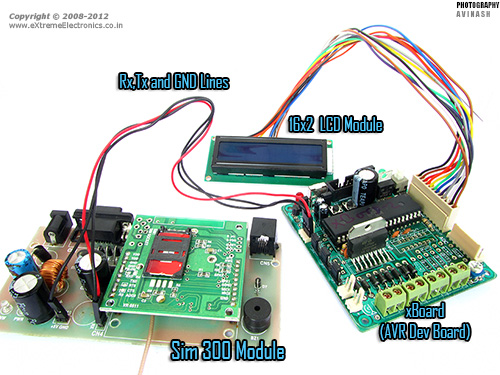 |
Fig. SIM300 and ATmega32 Connection |
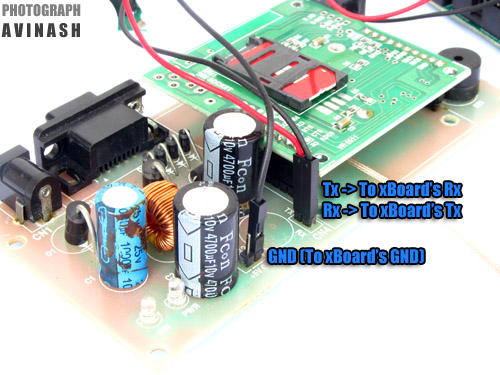 |
Fig. SIM300’s PINs |
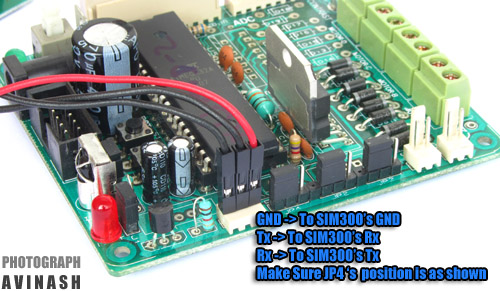 |
Fig. xBoard’s USART PINs |
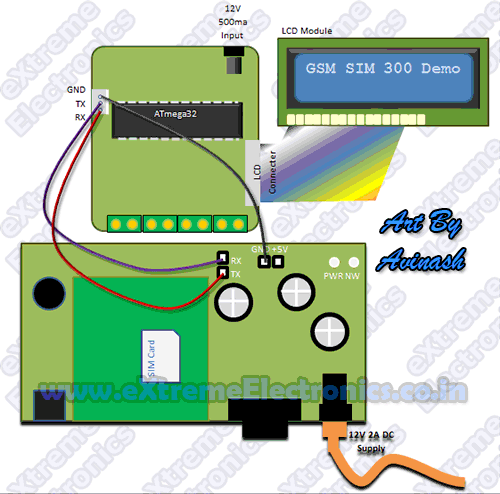 |
Fig. GSM Module connected with ATmega32 |
After completing the connection, power up xBoard 2.0 using a 12v 500 ma DC adaptor. And program the board with the HEX file for the project(download available at the end of article). Then insert a SIM card in SIM300 module and power it up using a 12v 2A DC Adaptor. Restart the xBoard 2.0 using its reset button.
Here are some links for your help.
- For programming xBoard 2.0 you will need an USB AVR Programmer.
- The steps of programming are given here: http://xboard.extremeelectronics.co.in/Programming.htm
- More information on various parts of xBoard 2.0 are here: http://xboard.extremeelectronics.co.in/Know_xBoard.htm
NOTE
The board shown below is the new version of SIM300 Modem, it can also be used to make this project. New version is much smaller and low cost.
Fig. SIM300 Module New Version |
Source Code for the Project
/******************************************************************************
SMS Based Voting System.
NOTICE
--------
NO PART OF THIS WORK CAN BE COPIED, DISTRIBUTED OR PUBLISHED WITHOUT A
WRITTEN PERMISSION FROM EXTREME ELECTRONICS INDIA. THE LIBRARY, NOR ANY PART
OF IT CAN BE USED IN COMMERCIAL APPLICATIONS. IT IS INTENDED TO BE USED FOR
HOBBY, LEARNING AND EDUCATIONAL PURPOSE ONLY. IF YOU WANT TO USE THEM IN
COMMERCIAL APPLICATION PLEASE WRITE TO THE AUTHOR.
Change Log
21 Dec 2012 - Added EEPROM Initialization on first boot, added function
SIM300SetTextMode()
WRITTEN BY:
AVINASH GUPTA
me@avinashgupta.com
*******************************************************************************/
#include <avr/io.h>
#include <util/delay.h>
#include <avr/eeprom.h>
#include <string.h>
#include "lib/lcd/lcd.h"
#include "lib/sim300/sim300.h"
#include "lib/usart/usart.h"
void Halt();
void Reply(const char *num,uint8_t stat);
int main(void)
{
//Initialize LCD Module
LCDInit(LS_NONE);
//Intro Message
LCDWriteString("Msg Based Voting");
LCDWriteStringXY(0,1,"By Avinash Gupta");
_delay_ms(1000);
LCDClear();
//Initialize SIM300 module
LCDWriteString("Initializing ...");
int8_t r= SIM300Init();
_delay_ms(1000);
//Check the status of initialization
switch(r)
{
case SIM300_OK:
LCDWriteStringXY(0,1,"OK !");
break;
case SIM300_TIMEOUT:
LCDWriteStringXY(0,1,"No response");
Halt();
case SIM300_INVALID_RESPONSE:
LCDWriteStringXY(0,1,"Inv response");
Halt();
case SIM300_FAIL:
LCDWriteStringXY(0,1,"Fail");
Halt();
default:
LCDWriteStringXY(0,1,"Unknown Error");
Halt();
}
_delay_ms(1000);
//Set message format to text
r= SIM300SetTextMode();
LCDClear();
LCDWriteString("Set Text Mode ..");
_delay_ms(1000);
//Check the result of above operation
switch(r)
{
case SIM300_OK:
LCDWriteStringXY(0,1,"OK !");
break;
case SIM300_TIMEOUT:
LCDWriteStringXY(0,1,"No response");
Halt();
case SIM300_FAIL:
LCDWriteStringXY(0,1,"Fail");
Halt();
default:
LCDWriteStringXY(0,1,"Unknown Error");
Halt();
}
_delay_ms(1000);
//IMEI No display
LCDClear();
char imei[16];
r=SIM300GetIMEI(imei);
if(r==SIM300_TIMEOUT)
{
LCDWriteString("Comm Error !");
Halt();
}
LCDWriteString("Device IMEI:");
LCDWriteStringXY(0,1,imei);
_delay_ms(1000);
//Manufacturer ID
LCDClear();
char man_id[48];
r=SIM300GetManufacturer(man_id);
if(r==SIM300_TIMEOUT)
{
LCDWriteString("Comm Error !");
Halt();
}
LCDWriteString("Manufacturer:");
LCDWriteStringXY(0,1,man_id);
_delay_ms(1000);
//Manufacturer ID
LCDClear();
char model[48];
r=SIM300GetModel(model);
if(r==SIM300_TIMEOUT)
{
LCDWriteString("Comm Error !");
Halt();
}
LCDWriteString("Model:");
LCDWriteStringXY(0,1,model);
_delay_ms(1000);
//Check Sim Card Presence
LCDClear();
LCDWriteString("Checking SIMCard");
_delay_ms(1000);
r=SIM300IsSIMInserted();
if (r==SIM300_SIM_NOT_PRESENT)
{
//Sim card is NOT present
LCDWriteStringXY(0,1,"No SIM Card !");
Halt();
}
else if(r==SIM300_TIMEOUT)
{
//Communication Error
LCDWriteStringXY(0,1,"Comm Error !");
Halt();
}
else if(r==SIM300_SIM_PRESENT)
{
//Sim card present
LCDWriteStringXY(0,1,"SIM Card Present");
_delay_ms(1000);
}
//Network search
LCDClear();
LCDWriteStringXY(0,0,"SearchingNetwork");
uint8_t nw_found=0;
uint16_t tries=0;
uint8_t x=0;
while(!nw_found)
{
r=SIM300GetNetStat();
if(r==SIM300_NW_SEARCHING)
{
LCDWriteStringXY(0,1,"%0%0%0%0%0%0%0%0%0%0%0%0%0%0%0%0");
LCDWriteStringXY(x,1,"%1");
LCDGotoXY(17,1);
x++;
if(x==16) x=0;
_delay_ms(50);
tries++;
if(tries==600)
break;
}
else
break;
}
LCDClear();
if(r==SIM300_NW_REGISTERED_HOME)
{
LCDWriteString("Network Found");
}
else
{
LCDWriteString("Cant Connt to NW!");
Halt();
}
_delay_ms(1000);
LCDClear();
//Show Provider Name
char pname[32];
r=SIM300GetProviderName(pname);
if(r==0)
{
LCDWriteString("Comm Error !");
Halt();
}
LCDWriteString(pname);
_delay_ms(1000);
//Voting system
uint16_t votes[4];
votes[0]=eeprom_read_word((const uint16_t *)0);
votes[1]=eeprom_read_word((const uint16_t *)2);
votes[2]=eeprom_read_word((const uint16_t *)4);
votes[3]=eeprom_read_word((const uint16_t *)6);
if(votes[0]==0xFFFF)
{
//No valid data on eeprom, so set all votes to 0
votes[0]=votes[1]=votes[2]=votes[3]=0;
//Clear EEPROM too
eeprom_write_word((uint16_t *)0,0);
eeprom_write_word((uint16_t *)2,0);
eeprom_write_word((uint16_t *)4,0);
eeprom_write_word((uint16_t *)6,0);
}
//Wait for MSG
uint8_t id;
char oa[20];//Origin Address ()the number from where the msg came
UFlushBuffer();
while(1)
{
LCDClear();
uint8_t x=0;
LCDWriteStringXY(0,0,"A= B=");
LCDWriteStringXY(0,1,"C= D=");
LCDWriteIntXY(2,0,votes[0],4);
LCDWriteIntXY(9,0,votes[1],4);
LCDWriteIntXY(2,1,votes[2],4);
LCDWriteIntXY(9,1,votes[3],4);
while(SIM300WaitForMsg(&id)!=SIM300_OK)
{
if(x)
{
LCDWriteStringXY(15,0,"%3");
x=0;
}
else
{
LCDWriteStringXY(15,0,"%4");
x=1;
}
}
LCDWriteStringXY(15,0,"%2");
_delay_ms(1000);
//Now read the msg
char msg[300];
r=SIM300ReadMsg(id,msg,oa);
if(r==SIM300_OK)
{
if(strcasecmp(msg,"VOTE A")==0)
{
votes[0]++;
eeprom_write_word((uint16_t *)0,votes[0]);
Reply(oa,1);
}
else if(strcasecmp(msg,"VOTE B")==0)
{
votes[1]++;
eeprom_write_word((uint16_t *)2,votes[1]);
Reply(oa,1);
}
else if(strcasecmp(msg,"VOTE C")==0)
{
votes[2]++;
eeprom_write_word((uint16_t *)4,votes[2]);
Reply(oa,1);
}
else if(strcasecmp(msg,"VOTE D")==0)
{
votes[3]++;
eeprom_write_word((uint16_t *)6,votes[3]);
Reply(oa,1);
}
else
{
//Invalid Choice
Reply(oa,0);
}
_delay_ms(3000);
}
else
{
LCDClear();
LCDWriteString("Err Reading Msg !");
_delay_ms(3000);
}
//Finally delete the msg
if (SIM300DeleteMsg(id)!=SIM300_OK)
{
LCDWriteString("Err Deleting Msg !");
_delay_ms(3000);
}
}
Halt();
}
void Halt()
{
while(1);
}
void Reply(const char *num,uint8_t stat)
{
uint8_t ref;
int8_t r;
if(stat)
r=SIM300SendMsg(num,"Your vote has been successfully registered, Thank ! :)",&ref);
else
r=SIM300SendMsg(num,"Invalid vote ! Please send VOTE x, where x can be A,B,C or D.Thanks!",&ref);
if(r==SIM300_OK)
{
return;
}
else if(r==SIM300_TIMEOUT)
{
LCDClear();
LCDWriteStringXY(0,0,"Can't Send Reply!");
LCDWriteStringXY(0,1,"Time out !");
_delay_ms(3000);
}
else
{
LCDClear();
LCDWriteStringXY(0,0,"Can't Send Reply!");
LCDWriteStringXY(0,1,"Fail !");
_delay_ms(3000);
}
}
The source code is written in C language and compiled using the avr-gcc compiler with the help of latest Atmel Studio 6 IDE. The source code is dependent on the following libraries.
- The LCD Library.
- The USART Library.
- The SIM300 library.
Notes
- If you are using a new ATMega32 MCU from the market set the LOW FUSE as 0x3F and HIGH FUSE are 0xC9.
- If you get NO display on LCD, adjust the contrast adjust preset RV1.
- Brownout detector is Enabled to prevent corruption of EEPROM, Brownout level is set to 4.0 volts. The above fuse bits ensure the proper brown out detector settings.
 |
Fig.: Setting the Fuse bytes. |
Reference
This project is based on SIM300 GSM Module, following tutorial explains more about the module :
Downloads
Help Us!
We try to publish beginner friendly tutorials for latest subjects in embedded system as fast as we can. If you like these tutorials and they have helped you solve problems, please help us in return. You can donate any amount as you like securely using a Credit or Debit Card or Paypal.
We would be very thankful for your kind help.
By
Avinash Gupta
Facebook,
Follow on Twitter.
www.AvinashGupta.com
me@avinashgupta.com
Facing problem with your embedded, electronics or robotics project? We are here to help!
Post a help request.


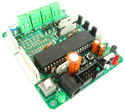








Hello Avinash,
Your tutorials on GSM interface has really boosted my moral to venture in this area. Great job indeed. I had a project in my mind but could not get started due to lack of exposure, which your tutorials have given me. I seek a little guidance from you in this regard. It is as follows:-
Make a call to GSM module and get a voice message recorded. Then send a sms containing few mobile numbers. Now, the GSM module should call each of these numbers and play the recorded message.
Thanks in advance
give the advantage of this project
Hi, A , avinash can you please send me some data sheets or some IEE papers on the same for my refference. this would help me for my seminar.
Please reply me.
Thanks You
Rupa.
Dear Sir,
I have build a same project as an interest and learning basics of GSM module. I have compiled and downloaded the program. However, when one vote registered it automatically halted sometimes only VOTE A works nad vote B not works some time vice versa.
Can you please guide me?
What is your Order ID for purchase of xBoard and GSM Module?
Hi kiran… I’m also trying the same project. In that It simply waits for a msg. Not receiving any msg. Do i need to change anything in the code or connections? please let me know.
would you mind plz give me the pcb layout for the sms based voting system.
can this project turn to STUDENT RESULT CHECKER SMS RETRIEVAL?
May i know why do we use L1 and C3?
helo sir please send me the list of projects for ece students
how do i reset all the counters???
Dear Sir,
I want to build a finger print based voting macine project . so i needs serial communication code with atmega8/16/32/ or 128
Can you please guide me?
there is function SIM300SetTextMode(), I hope it is sending AT+CMGF=1 command to the module. But, is it enough if we execute this function only once at the start of the program after initialization??
dear soni,
yes u need to issue this command only once on powerup, it is sufficient.
hello sir…
i want to know thw originating address of the received message can u help me how to dfind it….in this project u have written oa in sendmsg function bt i do not get the oa.
good projects! now i starting this projects.
sir the receiving of message is not properly done. many times it does not display the initial characters. also i am trying it on atmega 16. i hav reduced the code size but still it gives error. can u rectify it o say the changes.
Sir, where can i get the SIM300 library?…… i have seen you in separate projects that you have uploaded the LCD library, but what about that of SIM300?
Respected Sir,
I really love your tutorials and i just have a doubt can i use your SIM300 library to a code written in Winavr or not please let me know and sir can i use them for SIM900 module bought from your site
can i design x board myself?
and also i am having problem with the r = SIM300ReadMsg(id,msg,oa);
oa is undefined
HELLO ! Avinash sir , I am working on cellphone based voting system for my project but i can’t use x2 board i have to make it in zero pcb . i have burnt my ic atmega32 from market using hex file . The circuit diagram above atmega32 schematic and its connection to sim300 also have done but lcd doesn’t show require output but lcd is on.
Tell me sir that above ckt diagram is of board or not.
Reply me soon
plz
@AMIT,
You should first make it exactly as shown i.e. using xBoard v2.0 only. Or get the complete setup prepared by our expert staffs.
Then you should move on to making the same circuit using general purpose PCBs (that you are calling zero pcb)
hlw sir can i share a project with you??
@Programmer
Please send it to may email ID.
Hi kiran… I’m also trying the same project. In that It simply waits for a msg. Not receiving any msg. Do i need to change anything in the code or connections? please let me know.
REPLY
how can we avoid double voting from this system. and how much do you sell it’s prototype. regards
@Mari,
Please let us know your contact details like address on our email ID. Thank you.
I am intrested in your project.
sir,if i am using atmeg16 what all changes should i made in the above project.
sorry I don’t know
sir,i am beginner,so please provide me with the procedures and block daigram of this project
sir, i have seen your project of wireless electronic notice board using GSM modem last time .. right now when i am prepared to buy th components from you i couldnt see that blog can u please help me out to find out that blog..so that it helps me in buying and referring to the doubts . THANK YOU
hello ,i dont have xboard and i cant buy it , but i have atmega32 ,is there is way to build the circuit without xboard ???uuu
Can u please mail me the SIM300 and usart library….
Sir i am a beginner at practical work. I wish to build it for my minor project. i cannot use the xboard. could you please help me with the circuit without using xboard.
@Ankita Gupta,
Since you have said that you are beginer at practical work, it would be tough for you to find and buy all the components separately. And their is no guarantee that you will find the exact parts required. Also the local dealers are known to fool peoples by selling components at very high rates and fail to provide any technical assistance. That’s why most peoples are struck at simple problems. And no one is able to provide that much personal time to any unknown person in the internet. Thats why extremeelectronics produces and sell products in a form that is easy to use. Once the user is familiar with working of project and satiesfied that the program is working in excellent condition then only they can move to soldering or other things to make the hardware them-self this time.
hello sir, thanks for the tutorial, i want the source code of the double vote avoiding system, i want to know how much it will cost,i will make the hardware myself because i do not live in India and i am trying to avoid the long shipping time and cost, please reply me with this email inteligentosax@gmail.com
@Osax, first make the hardware. I will give you the code for free.
hello sir, thanks very much for your reply, the hardware has already been made.
hello sir, i am still waiting for the source codes you said you will send,thanks.